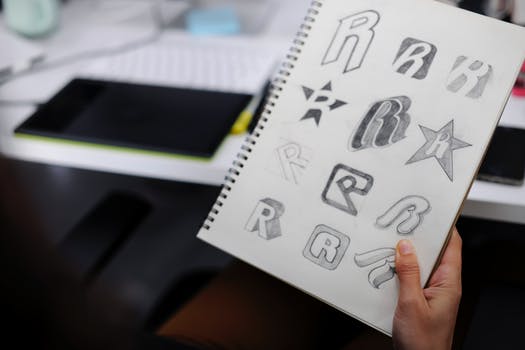HR Marketing: Does Your Human Resources Logo Feel Too Impersonal?
Posted on November 29, 2018 by Logo Design Tips and Tricks

Having a good logo is important in any profession, but it’s especially crucial if you work in human resources. As a human resources firm, you want your human resources logo design to convey the right message.
If people are going to use your services, they need to be able to trust you. Your logo is the most visual representation of your company. It may be the first — or only — impression potential clients are going of off when making a decision about hiring.
Human resources is also a very personal line of work, and so you want your human resources logo to reflect that. The right colors or style could be the difference between getting business or losing it.
Below, we’re sharing some human resources logo inspiration that will get you thinking about the perfect logo for you. Read on to learn more.
1. Consider Your Brand
The best human resources logo ideas start with a clear understanding of what your brand is and what traits you want to portray. Before you start designing, you should take some time to think about the personality you want to portray to potential customers.
You likely want to come across as trustworthy, supportive, and knowledgeable, but what else? How do you want your clients to feel after they have used your services or interacted with your employees?
There is a lot that goes into human resources — from interviews to police check services, to on-boarding. To create a good logo, you’ll need to distill that down into a few simple ideas that can be represented visually.
2. Look at the Competition
Human resources logo inspiration can come from anywhere, including other companies in your industry. You never want to copy anyone else’s logo or style directly, but it can be a good source of ideas.
It’s important to pay attention to what you don’t like, in addition to what you do like. If you’re stuck on what direction you want your human resources logo design to take, it can be helpful to know what not to do.
3. Solicit Feedback
You don’t have to get your logo right on the first try. In fact, doing so will probably be impossible. Even if you know exactly what colors or text or graphics you want, there will be many possibilities for how to put them all together.
Feedback will be your most powerful tool in narrowing down your options to arrive at your final logo design. Ask trusted employees, friends in other industries, or even former or current clients. Even if there isn’t unanimous consensus, the feedback will be helpful in revising the design until you get to the finished product.
Ready to Start Designing Your Human Resources Logo?
There is a lot involved in coming up with the perfect human resources logo for your firm. You want something that will grab people’s attention, but also say the right thing about your company.
Try to keep your personal design sense out of the decision, and come up with a logo that truly represents what your company is and what you want it to be.
For more information on creating the perfect logo for your company, explore our blog.
5 Eye-Popping Logo Design Trends For Your Optometrist Business
Posted on November 28, 2018 by Logo Design Tips and Tricks

Did you know there are about 41,000 optometrists in the United States?
With so many optometrist businesses, it’s easy for an optometrist business to fall through the cracks and not get the attention it deserves.
If you want your optometrist business to set apart from the competition, you need to create an excellent logo. Here are some logo design trends to consider for your optometrist business.
1. Think of Simplicity
Your optometrist business doesn’t need flashy and over the top logo designs to attract customers. In fact, you need to be straight to the point to make your logo memorable for your clients.
The simplicity logo trend focuses on delivering a clear message without a lot of details. Those who want to modernize to appeal to a younger audience should take this approach.
For example, Optometrist Sydney has a simple and to the point logo design.
2. Clean Shapes
If you are a fan of simplicity and clean edges, you should consider clean shapes for your logo design.
Clean shapes are great to look at especially when they display subtle curves, lines, symmetry, and straight lines.
Let your clients know what your business is all about by displaying clean shapes in your optometrist logo. For example, for an optometrist business, it might seem like an obvious idea to use circles and lines to create glasses.
But you can have a lot of fun with this to not make it as obvious.
3. Make it Fun
Optometry is a serious business so one might not think to make the logo fun. However, the point is to make it memorable.
A logo will identify your business so why not make it fun and creative. You can use characters, fun colors, or any other ideas that could make your logo fun. There’s no reason why you can’t make it fun.
4. Draw Inspiration from Architecture
When you look at some buildings that are well design, you discover how aesthetically pleasing they can be. The lines are straight and everything is there for a reason.
Why not draw inspiration from architecture to put it into your building. For example, if you live in a city with an iconic skyline, you can incorporate it into your logo to let your clients know your business is based in that city.
5. Layer Patterns and Colors
Layering colors and patterns is a logo design trend that is making an impact. This logo technique includes taking advantage of colors, shade, and even texture.
It can be easy to overdo this logo trend so you need to make sure only pick a few concepts to play with. You could choose colors and shades or shade and texture. Try not to use them all at once or it could clutter the whole thing.
Logo Design Trends for Your Optometrist Business
Keep these logo design trends in mind when you design your optometrist logo.
Think about simplicity, layer patterns, and colors, and get inspired by architecture.
Need help with your logo? Contact us and we can help your logo vision come true.
Impress for Success: How to Stand Out from the Competition
Posted on November 26, 2018 by Logo Design Tips and Tricks

Your business needs to pop.
Getting noticed among countless competitors can seem like a daunting task. However, figuring out how to stand out should just be part of your business strategy. It doesn’t matter if you’re selling batteries or baking cupcakes.
Here’s what you need to do.
Update Your Website
A slow, ugly website will kill your business. It doesn’t matter if you’re not planning to sell anything online.
To glean ideas, scope out the competition’s websites. The goal isn’t to copy them but to learn from them. Are they using lots of bold, attention-grabbing colors? Is their site filled with gorgeous pictures?
Visitor management tools can help you determine if your plan is working. After reworking your website, you should see a corresponding spike in traffic.
Be Funny
Everyone, businesses and consumers alike, uses social media. There’s a good chance that your company already has a Facebook, Twitter, etc, account.
But are you putting it to good use? People don’t like rote, run-of-the-mill responses. they want humor. Excitement.
So, if you want to stand out from the crowd, try crafting a witty social media personality. Stay away from offensive humor and don’t deviate from the brand message too much.
Pick an Influencer
We live in the day of the influencer. Every day, regular people who have amassed a following on a social media platform. Finding the right person to promote your business is like finding a gold mine.
There’s a misconception that influencer campaigns are expensive. The reality is that you can spend as much or as little as you want. Instead of throwing all of your money at whoever has the most followers, find someone who appeals to your customer base.
Many people are willing to promote a company in exchange for goods.
New Advertising
Advertising is a constant expense. Your strategy should be flexible. Even if something is working, that doesn’t mean that you can’t be doing better.
Choose a bold advertising plan if standing out is important to you. Humor works for a lot of brands.
Certain brands can also get success by creating trends. Think tuxedo-wearing dogs running around a casino floor. The idea is to create a positive, alluring image that sticks wih people.
New Inventory
If your business relies primarily on selling a product, how’s your inventory? How long has the product been around? To keep people interested you might need to diversify your product line.
If that’s not an option, think of ways that your product can appeal to new consumers. If you’re selling soccer balls, think of ways to market them to retirement homes.
You’ll stand out by default if you discover a potential market that your competitors aren’t going after.
Choose a Logo
Your logo represents your brand’s spirit. If you choose something bland or unremarkable, it’ll be hard to tell your company apart from the competition. People will forget all about you.
A dynamic logo can change everything. Contact us for fresh ideas when you’re ready to get started.
How to Show Your Logo in Your Presentation Without Looking Too Pushy
Posted on November 10, 2018 by Logo Design Tips and Tricks

With every PowerPoint presentation, you put your brand on the line.
What? PowerPoint? Really?
It’s true. It’s easy to forget that PowerPoint presentations are also a form of marketing. Not only do you want to educate your audience, you want to increase brand awareness with every slide.
That’s why it’s important to show your logo in the most effective way possible.
But how do you do this without being too pushy?
Read on to find out more.
Is Your Logo the Right Fit for Your Brand?
If your logo doesn’t translate well across your marketing materials, that’s a sign that you may need to go back to the drawing board – literally.
One of the basic principles of successful logo design is adaptability. Ask yourself: How well does your logo adapt to brochures, social media, TV commercials, and informational marketing materials like PowerPoint presentations?
A strong logo should maintain its integrity when it’s shrunk down for business cards or blown up for billboards.
The same applies to your PowerPoint presentations. If your logo still distracts despite being minimized, transparent, or animated, you may want to rethink your logo design altogether.
Focus groups and A/B testing can reveal whether or not your logo successfully adapts across all marketing material.
How to Brand Your PowerPoint Presentations
After fine tuning your logo, your next step is to ‘brand’ your presentations.
But what does ‘branding’ a presentation even mean?
For starters, it doesn’t mean plastering your logo all over your slides. It means working in tandem with other elements to successfully reflect a brand’s message. You can’t successfully integrate a logo without the right accompanying font, color scheme, tagline, slide border design, and media.
You’ll want to find a way to integrate these branding elements without coming across as pushy.
How to Master the Art of Subtlety
Informational marketing, in particular, must put authoritative information front and center. This includes your data, statistics, charts, results, case studies, and company forecasts.
One way to subtly integrate your logo is to tweak its opaqueness to create a more transparent look. This is ideal for introductory slides, conclusions, and slides with testimonials, mission statements, and company history.
Ideally, only your introductory and conclusion slide should prominently feature your logo.
Show Your Logo ‘In Action’
If you’re including professional photos in your slides, make sure your logo is visible on employee uniforms, equipment, company vehicles, packaging, and work environments. This is a great way to show your logo ‘in action.’
Ask yourself how you want people to feel about your brand and put that feeling to work in your presentation.
If you’re an organic garden company promoting your new plant food, you may want to include a picture of a customer using your name-brand plant food.
Likewise, if you run a factory, make sure your company logo is visible on your workers’ attire.
Integrate Digital Media
You’ve heard time and time again that content is king, but don’t forget that video is the king of content. Still, more than 70% of consumers prefer video and almost 60% of executives prefer watching video.
As content preferences continue to evolve, it’s vital to read more on how to improve your PowerPoint presentations. That’s why more companies are integrating digital media into their slides.
But how do you include digital media without pushing your brand too hard? Branded company videos.
Make sure all your company videos begin and end with your logo. Preferably, animate your logo to grab your audience from the start. You may want to consider an original instrumental to accompany your animated logo as well.
Integrate Social Media
Another way to subtly show your logo is to embed social media content into your slides.
Content can include:
- Twitter polls
- Popular Tweets
- YouTube videos
- Facebook posts
- Instagram photos
- Hashtag campaigns
- Snapchat snaps
Embedding your branded social media content is a clever way to integrate your logo without going overboard.
Let this also be a reminder to brand your social media accounts ASAP! Embedding branded social media content allows online audiences to share your slides with colleagues. This is a subtle way to increase brand awareness without being pushy.
De-Clutter your presentation
It’s easy to go a little overboard with your graphics, pictures, media, graphs, and yes, your logo.
After completing your slides, make sure there isn’t too much media plastered on each slide. If your slide already has a branded video, you don’t need to add more photos or graphics.
Avoid overlapping your logo with graphics and using background wallpaper with your repeating logo. You want your presentation to look as clean and professional as possible.
Don’t worry about whether or not your audience remembers your logo. If your mission, content, and brand design are consistent and strong, your audience will have no problem making a positive connection with your logo.
Day of the Presentation
It’s finally presentation day!
Your presentation is complete. Here are a few tricks to help your audience remember your logo.
As mentioned earlier in this article, your introductory slide should prominently feature your logo. Make sure your presentation is fired up and ready to go several minutes before the presentation starts. This will give attendees funneling in an opportunity to see your logo before the presentation starts.
The same applies to your conclusion slide.
After your presentation is over, don’t immediately shut off your presentation. Let the conclusion slide stay up on the screen until you’re finished mingling with attendees.
Remember, your company’s logo is the first and last thing your presentation attendees should see.
Your Next Step
Your next step is to put these new principles into practice.
Remember the following:
- Choose a logo that speaks to your brand
- Choose subtlety over flash
- Show your logo in action
- Use digital and social media
- De-clutter your slides
- Highlight your intro and conclusion slides
Most importantly, never stop improving your presentations. Remember to bookmark this article for future reference and check back often for more tips and tricks on mastering your logo.








